The Leica M 240 at Night
by Ivan Makarov
A few weeks ago, I had a chance to visit New York City for a few days, focusing only on photography. Well, I focused on the food too, as it’s kind of legendary. Because I live on the West Coast, near San Francisco, NYC was an eye-opening experience in many ways, as I discovered a new culture, new kinds of architecture, and a new big city I heard so much about but never visited before with my camera.
I also used the visit as a chance to keep learning my new Leica M, which I acquired last summer before the birth of our son Yuri who’s doing great, by the way and is sleeping in my arms as I type this.
Up to this point, I’ve been using Leica mostly during day light, and sometimes indoors for family snaps around the house. It’s an amazing camera in those situations. When I was choosing between getting a new Leica M or a used M9, one of the deciding factors that swayed me towards getting the M was the high ISO performance, which Leica delivered with the improved sensor. I knew that some of the most important family photographs I would capture with this new camera would be indoors, or in darker conditions and having the ability to shoot clean images using ISO1600 or ISO3200 was worth paying extra money, at least for me.
When doing my research on Leica, I came across a lot of images online that were taken outdoors, but at night, using fast M-mount primes. There was something different about those images compared to what I’m used to seeing from SLRs in similar conditions. The colors looked more natural and vibrant. The contrast was beautiful. The sharpness was always top-notch.
As I thought about what to shoot in New York, I thought I’d spend some time in the evenings after dinner testing how Leica performs in those night conditions, using my Leica M, and Leica 35mm f/2 Summicron ASPH lens. I did have 50mm f/1.4 Summilux on me as well, but I spent most the trip shooting with the 35mm lens, as I just bought it, and also found it more suitable for street photography.
So how did Leica perform in those night conditions? In short, I was very happy with the results.
My goal was to capture the lights of New York as my eye saw them. The beauty of New York City at night is that it’s full of colors, lights, and contrasts, no matter where I look. Leica proved to be a very good companion in recording those scenes – just how I saw them, or even more beautiful when coupled with the rich Leica bokeh.
I shot these images with the wide open aperture, and using ISO1600. They were shot at China Town and Times Square – two locations that are excellent for night street photography.
The one downside was that the files still came out somewhat on the warm side, which Leica M is now known for. I had to pull down the saturation in reds and oranges a bit during post processing to restore skin tones to their more natural color. I’m used to doing it now. The recent firmware upgrade fixed those issues somewhat, as you noted in your article, but it did not fix it completely.
As a result of this trip and my new experience of shooting at night, I am now incorporating night street photography in all my photo related travels, especially when it’s a city that offers plenty of life after it gets dark.
My site – http://www.ivanmakarov.com/

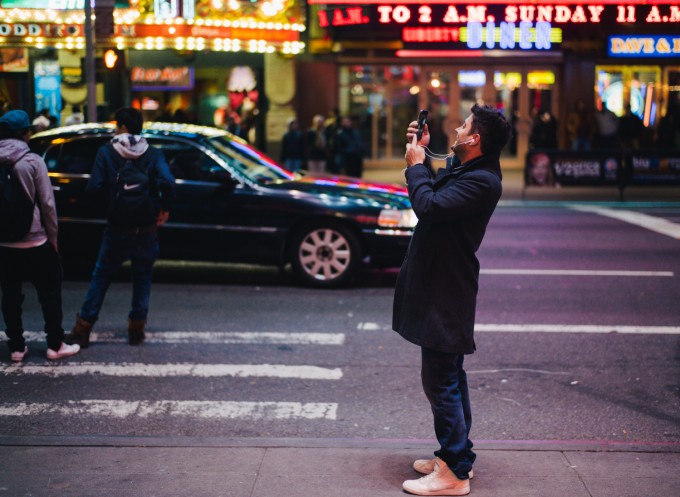
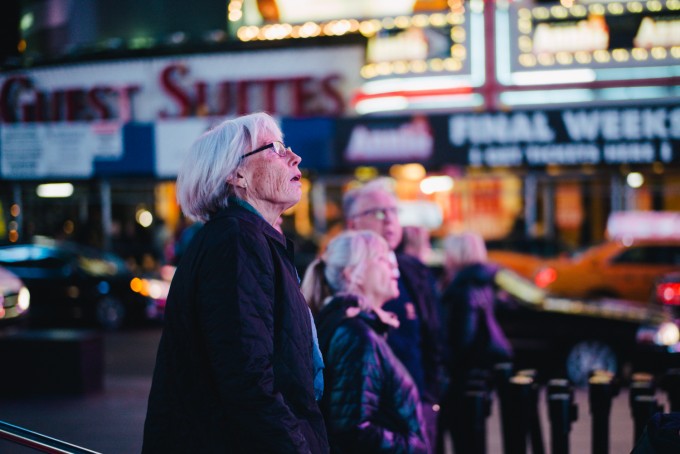
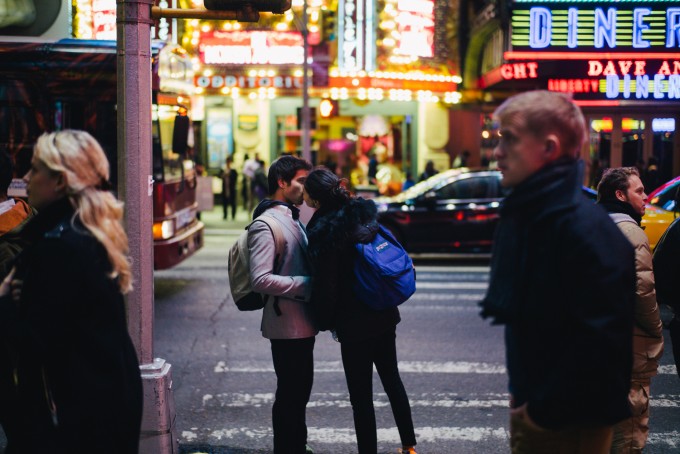
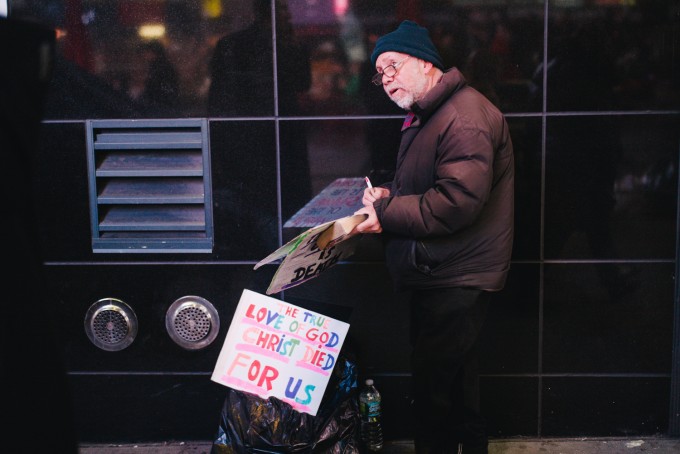
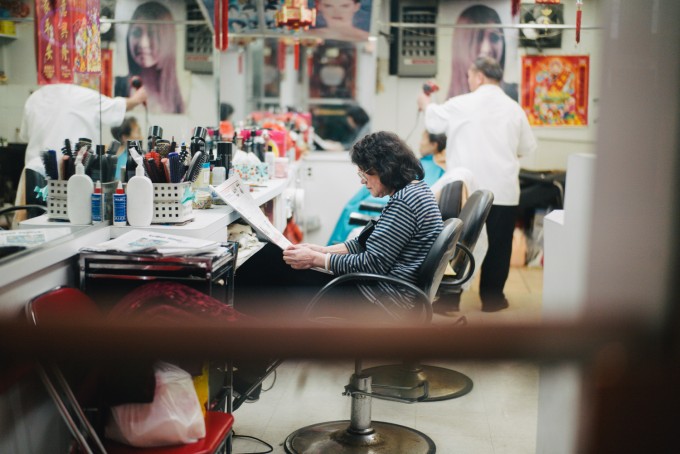
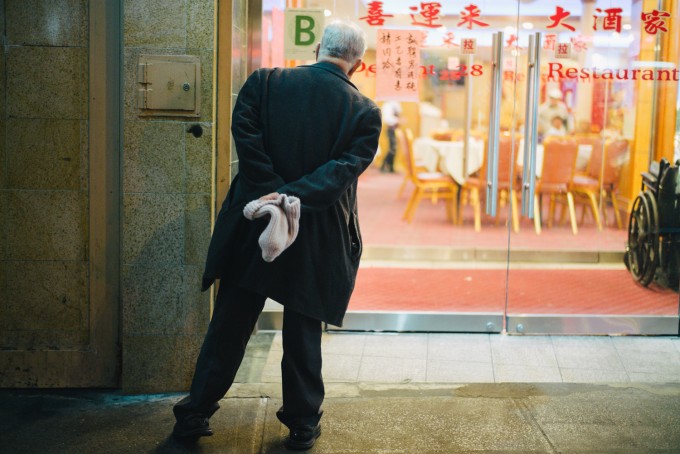
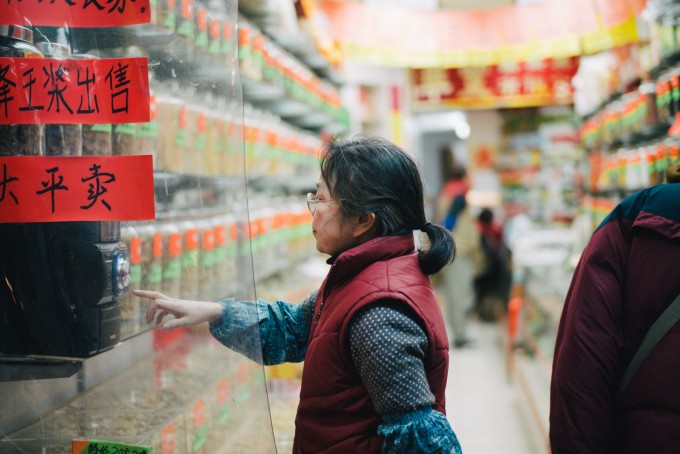
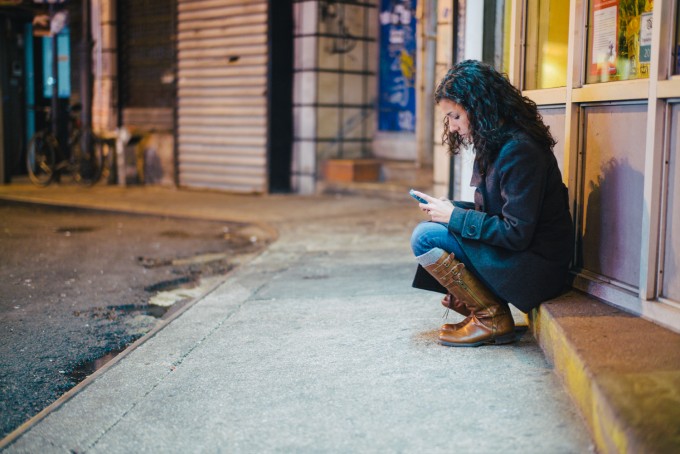
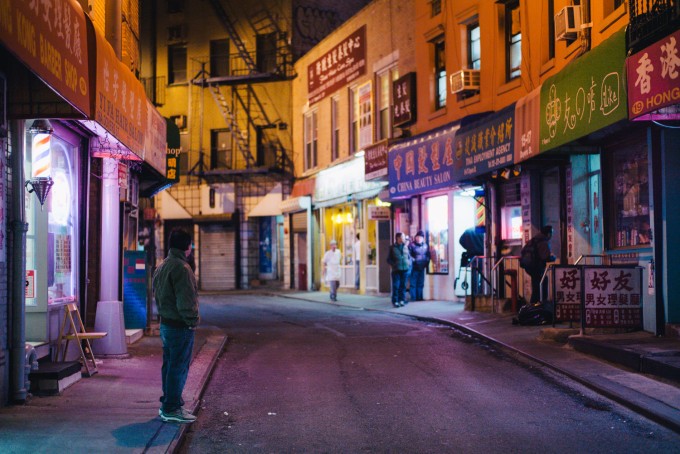



I am on the side of thinking these colors are quite accurate to the scene for the most part. Maybe there could be a small amount of corrections on a few of them but as someone who has been in NY many times this is very much the feel of NYC at night. The first photo in particular is perfect! It almost makes me feel like I’m there. 😉
First I have to comment about the pictures. Some shots are very interesting communicating the pulse of the night street life. Ivan you do have an eye for this and thank you for the photos.
Now to the technical part. The core of discussion goes again about the Leica issue. Leica is not the problem. The problem is how somebody handles it. Lenses are not the issue. The issue is how somebody uses the right lens for the job. If someones feel that they overpay for a Leica simply do not buy it. If somebody feels that Nikon Df is for the birds do not buy it. Yes all the digital bodies today have a short life and a steep depreciation curve. Within this concept Leica M and Nikon Df surely have a comparative advantage. If you buy a camera having in mind the next upgrade then you are trapped in a GAS.
The talk about pinkish colours, etc quotes straight out of the camera JPEG. This is not the way to do it. I consider much more better to take the pains and master the technique than blaming the gear in use. Any gear.
Regards,
Dimitris V. Georgopoulos
Photographer at Large
Athens, Greece
Excellent Point of View,……Petro
Difficult lighting that would have all cameras in a quandry as to which WB to go with, so all in all a pretty good result from the M.
I think most people’s negative comments are because with this type of subject they’re expecting to see mono or tinted at least and so going full colour is a little unsettling for them.
Maybe as an experiment try a couple processed as b/w and see if the reaction is different….^^
Good point Gene ! I am laughing as I type. Maybe deep down we are all gear heads. Was what I wrote evidence of a Freudian photo slip? On a more artistic topic-Hope everybody can take a few mins to check out Saul Leiter’s work. I am familiar with most of the old masters of Black and White but Leiter’s colour work was a revelation -a lot of it done in all weather conditions with slow colour transperancy film back in the day.
slow slide film in all weather conditions back in the day. Inspiring.
i am using Rokinon Ef lenses with metabones iii adapter on Sony A7, the pictures quality is not sharp as i hoped for. Am i doing something wrong?
Your feedback’s are welcome.
thank you
It’s sad to say but there are people whose only perception of any photograph is a technical one. Then the topic can rapidly degenerates into a camera Brand v Brand war and the message is always “You must get the latest and greatest”or the new camera I have.
Please let’s all concentrate on the image not the apparatus! Strange how most great photographers seem to be able to use many different cameras cheap or expensive to achieve superb results-how? It must be about knowing the limitations of the camera and working within them.
The great photographer Saul Leiter was one of the foremost masters of colour photography and I saw a documentary recently about him on the web and guess what camera he was using ? It was a Lumix! (G1 I think)
I use a Leica M8 (produces beautiful b+w images IMHO)and sometimes a Lumix G1 and guess what my colour photos are nowhere as good as Saul’s !
I occasionally purchase a Photo magazine called “Black and White Photography”.
What I like about it is amongst other things is that it rarely ever identifies the camera used to take published images -except in rare cases when an old vintage film camera or exotic process was involved.
Too much to hope for this to become a universal practice.
In the middle of telling us that equipment doesn’t matter you mention that the M8 produces beautiful beautiful B&W images. That’s all any of us are doing: commenting on the strengths and weaknesses of various pieces of gear in helping us achieve our artistic intent.
Yeah wonderfull B&W..also the M9, but they are sold as Colour Camera’s…
It’s not the photographer’s fault. The camera occasionally has some pink (magenta) and yellow overtones in shots taken under all manner of lighting, including daylight. It’s not the white balance; it happens when manual white balance is set from a card. The colors on the M9 were richer and more believable out of the camera—at least in firmware from the last couple of years. I think this might be what causes the flatter look of the M240 files, something people usually blame on its higher dynamic range (which isn’t obvious as the M240 also seems to blow highlights more easily than the M9). The “Leica glow” is harder to achieve. I’ve found that exposing a bit to the left while looking at the LCD screen helps. This can also improve skin tones, though it consigns you to manual exposure (or using exposure comp, a concept foreign to Leica shooters). Custom profiles help, too. Anyway, it’s not always a problem but requires a bit more work in post and even that doesn’t always fix it completely.
As a pro shooter, I now shoot about 90% of my jobs with my M240 & less-so my M9, with my Canon’s filling the remaining 10%. I have no trouble with the Leica white balance, noise, (unless I screwup the settings) how the cameras handle, how they feel, focus and in general, how they make me money. Numerous clients have said how they love the sharpness and great image quality. My kit is now generally lighter in-weight and because of the M240’s benefits I can travel with much much less lighting, making me more efficient at what I do, thus making me more competitive in the marketplace. Until one of my clients complains about the image-files coming from my Leica-generated images, the majority of complaints about the Leica system to me, are unfounded.
If reproducing as exactly as possible what one person’s eye thought it saw at one particular moment was what it’s all about, photography would be very boring.
To make comments about skin color at night in Times Square is ridiculous. The old couple looking up is looking at some super-sized LED screen that has the craziest spectrum you could possibly imagine and changes what it displays every few seconds. I am a cinematographer working with some very expensive LEDs made especially for the movie industry and even these will have green/magenta shifts over time. Color balance in these situations is completely a matter of personal choice. I know many people just love to bash Leica, but Times Square is not really the place to do it. I wish Steve could one day post a number of pictures taken there at night with different cameras and let readers guess. I bet you, the results would embarrass Leica lovers and haters alike.
Aside from all the criticism here, I think these pictures are exceptional…colour, composition, and moments captured. It was like I was walking alongside you. That’s how awesome these are to ME. Who am I to judge what works for others? I think they are awesome….thanks so much for sharing.
Ivan,
Thanks for posting. I really like the images. I agree they are a little warm or have a magenta look to them but I would assume a lot of that is from the lighting. Unsure if you did any white balancing during or when post-processing but I’m sure that would help some.
I own Leica M240 and Nikon Df. Without question the Df performs much better at high ISO, heck that is what makes the camera. Either way, at the end of the day I never have the expectation of pictures shot at ISO 1200 and above to have perfect colors. I almost always convert images above iso 1200 to either black and white or use VSCO film to give it a more film look. When I use VSCO film my expectation is for the colors to be a better representation of my feelings and imagination, not necessarily the correct colors.
At the end of the day, who cares, it should matter mostly to the one who took the picture.
Here are some M240 pics at ISO 2000
http://www.rangetraveler.com/page/2/
gage
Mixed artificial lighting is a challenge for most digital cameras, the top ones included. I wonder if the M 240 was on auto ISO here, and if any adjustments in white balance/colour balance (that’s the same I think) were made. The mostly strong magenta cast is certainly not as I remember these scenes, taking into account that skin tones, if that’s what you’re adjusting for, won’t look natural in that sort of lighting either.
My D700 was pretty bad in mixed lighting, my current D800 a lot better, better than this anyway, but still not perfect.
Please note I don’t (actually, never) feel the need for the statement “my camera blows camera x, y or z out of the water”.
These images make me want to go back to New York soon!
Number 8 – girl squatting with mobile – is the image that grabs me. Some of the others are OK street scenes, but no.8 really tells a story with good framing good composition and appropriate colour. To my eyes, of course.
Hm, don´t want to poop on a party but, Sony´s Nex 6/7 would trounce these images. There is too much magenta cast, dynamic range is poor and loss of detail is visible even on resized images.
Maybe there could’ve been more to be done with lightroom?
Perhaps it’s time to have a few no-brand posts with the names of the cameras/lenses only revealed after 20 comments or so..
I’m not sure it’s a good idea to publish lots of also-ran images; we’re all capable of some very ordinary shots and seeing more of the same with obvious technical/skills flaws is not very inspiring – comments soon become fixit clinics with inevitable disagreements. That’s OK if it’s a clinic you want, but I wonder if the OP or publisher had it in mind.
People want to be kind and encouraging but is this the forum for basic fixit? The web has made so many fantastic images easily available for immediate comparison so it’s tough. But that’s where we’re at.
That said, I thought the last image had the best NYC mood (was it the diagonal ladders evoking West-Side??); pity the sharpness was ordinary.
Very sane response James. Top price equipment doesn’t buy great imGes, as is on e again demonstrated here.
Well, speaking as someone who spends far more time looking at photos than specifications and “tests” all this technobabble leaves me completely cold, but the photos on the other hand I rather like. Also it’s great to see some colour street photography. So, so tired of seeing dull photos of nothing at all somehow pushed as “art” because they’ve been converted to black and white. Nice work Ivan, thanks for sharing.
Well, i think the magenta dominance give a nice mood to all images, yep skin tones are far from perfection but in this case i don’t see this like an issue.
About the performance in low light:surely some cheaper cameras can do a better job, but i really like how those images appears.
Hi
Nice photos
The faces are alittle red, as i wrote in my article Leica has fixed it , ao they say.
Anyway it is nice to see how good the ISO works on this camera unlike the M9
I’ve shot new York and other cities at night with film, digital, cell phones… This magenta cast isn’t normal!
Only on the last photo it could be coming from the strange neon lighting the shop (butcher?) On thé left of the frame.
If this is not a weird white balance setting, there’s something wrong about how this sensor deals with those situations.
Much “lesser” cameras could easily match this file quality. And a Nikon Df or Sony RX1(r) output would wipe the floor with the M under the conditions these shots were taken.
Agree….Low light is and has been the week spot of the Leica m8 and m9 and hasn’t much improved in the M240.
I Write before here…my Nikon Df blows this away, also the D600/800 or Canons.
But he…this is not the place to make that stement
The authority has spoken.
My M240 would blow these away also, and I doubt that a Df with its 16megapixels and a poor Nikon lens will equal the picture quality of the M240 with Leica glass. I don’t think these pictures are particularly compelling, though not as bad as the comments of some here make them out to be. We have no idea what white balance setting the shooter used, or what post processing was employed. Hard to draw any meaningful conclusion about the camera without knowing those facts, something M.van den Broek should know. Finally, I have to say that I do not understand the desire to take night time color photographs. I think they are almost all inadequate. That’s why I prefer B&W at night. A Monochrom is the way to go for night photography.
You “don’t understand” quite a lot it seems from your recent postings, apart for your evident love affair with your Leica.
Other peoples pictures “inadequate”? By whose standards, just yours? How arrogant. You prefer B&W, ok, subjective, but then to try and make a definitive statement -a monochrome “is the way to go”adds nothing to the debate. Nothing at all. Brand ass-kissing at its best, doesn’t matter what brand it is. Lol.
There are lots of people who love shooting night pictures in well-lit cities, they can make for some compelling images. And a lot of them are quite “adequate” as well. 😉
Authority? not me…but read DXO and many others
Grant…It’s useless to debate with ‘Leica-people’…Leica -Glow, Unmatched Optics you name it.
Jack write…”I doubt that a Df with its 16megapixels and a poor Nikon lens will equal the picture quality of the M240 with Leica glass”
Nikon lenses..poor ? but he…for someone with only a Hammer everything is a nail.
I am a Photographic engineer, repaired, justify, calibrate Camera’s and Lense for over 40 years.
Sure Leica glass is top !, small and excellent corrected. So is Zeiss, Angenieux, Voigtlander (yep Mr Kobayashi knows his trade) and some others.
Nikon Kogaku has a solid History of excellent Lenses. Only the cheap ‘E’ lenses were dramatic, but than again they made a 80dollar 50mm f/1.8…
I use my 1960 Nikkor-P 105mm f/2.5 A type now on a Df, and beside the improvements in Coating of lenses, this Nippon Kogaku performs very well on the Df.
So i am from the land of the Windmills, but I am not fighting against them.
I like both Leica and Nikon lenses, some of them are superb, some not.
But the Digital M serie so far brought nothing new to the table and that’s
hard to accept if you’re a Leica-man (not much women).
So a superb 50mm f/1.4 Summilux will also excel on a 24Mp Sony A7, with or without postprocessing for 1/5th of the body price of a M240.
I take them apart and look what is inside…..
Hans, I recently picked up a Nikon 50/1.8 E-series for $10 in Williamsburg Va and its image quality and build (particularly compared with latter day plastics) are excellent.
I’ve compared it alongside my 2 Ai(s) Nikkor 50mm’s (1.4 and 2) using an Nex-7.
Apparently the element formula is the same, but the construction is certainly lighter. I stand to be corrected though.
I think my comment got partly missunderstood. My statement do not refer to shots or the potographer, but on the file quality of the M240 as this post is about the M. As a M9 and Df shooter, I dare to have an opinion.
Michiel, klopt…Dit is echt een kerk voor Leica, andere meningen niet toegstaan, maar de laatste tijd zijn er meer mensen die de nonsense rond de M240 en Monochrom neerzetten en zich niet laten wegjagen
James, Correct… a 50mm is a 50mm, old design.
I think the quality of the glass makes the difference and the way the aberration is corrected.
Leica add’s floating lens elements in the summilix
And the Nikkor 50 f/1.4 comes from china since 2000, same as the E series
Mooi antwoord Hans! Sommige mensen hier… 😉
Ach Hans, het is wel lachen, en leuk zo af en toe de knuppel in dit hoenderhok te gooien. Het is vast heel erg om een spieglreflex de ideale cameravorm te vinden, en vast nog erger als je het uiteindelijke beeld eigenlijk interessanter vindt dan het spul waarmee het is gemaakt. Er komt hier heel veel saais voorbij, en soms iets moois.
Misschien moet ik eens proberen iets gepost te krijgen…
Michiel,
Ja een Spiegelreflex is hier zoiets als de AntiChrist…
Vergeet niet dat de site overwegend amerikaans is en zo ook dhr Huff zelf. Af en toe als de kava dood is krijg je een diarree van medeleven ed.
En mensen die hier de grootste bagger posten als ‘Experience’ krijgen normaler wijze de ene lofuiting na de andere. Alleen bij deze ging het anders, gewoon omdat zo’n M9 of M240 totaal ongeschikt is boven 800 ISO… da’s het terrein van de D600, D4, D800 en Df.
Ik henzelf jaren een M8/M9 gehad, gewoon omdat het met liefde is gemaakt, maar vorige maand nadat e=ik een Df had gekocht en’s avonds gewoon echt met 6400 Iso kan schieten, was ik er klaar mee.
En dan loopt er hier er ook iemand te beweren dat zwart-wit dus beter en mooier is voor avond en nacht, lees zijn monochroom.
En dan dat eeuwige gezeur dat ‘straatfotografie’ het domein van de rangefinder is. Nou ik kan je vertellen dat het net een Df prima gaat en dat Autofocus een zegen is
Ik sjouw nog steeds af en toe met mijn Hasselblad 501CM rond…gewoon voor de fun en het feit dat negatief een ander materiaal is
Such a sad and defensive comment, once again Jack L. I wonder why.
Nothing sad and defensive unless viewed through Leica hater eyes. I pointed out that we know nothing about the decisions that were made by the shooter about setting up his camera or the processing choices that were made. I add that we are all looking at internet images on different monitors. How can anyone reach the conclusions that are routinely reached by you purported “experts” here relying on such “evidence”? DXO is only one method of evaluating sensors, and the test of the new M as I recall rated the new sensor quite high, not up to the D800, granted, but quite close, close enough that most real experts concede that the new Leica M sensor with great Leica glass and the M processor can turn out images as good as or better than the D800. If you dispute this just look on the internet and you will find reports that reach this conclusion.
Or are all these reports written by chopped liver, by people who are defensive, “coolaid drinkers”, Leica “fanboys” or the other derogatory terms you people love to throw around.
I pointed out that a Leica M with Leica glass will outperform the Df. By that I mean in the daylight. Is there any evidence that that statement is not true? Leica M files are brilliant, and that is what the pros (who see everything) who print my images tell me. Of, I forgot, they must be fan boys, drinking coolaid also.
My not liking night time pictures in color is a pure value judgment. Preferring a Monochrom for such work is also. Am I entitled to that? Or am I to be hated for that also.
Keep taking your pills as prescribed.
Oh, that’s so cute. What a jerk you are.
Jack,
DXO also test combination of camera and lens and rate dynamics. Doesn’t make better pictures, but it say something about the catch of light.
In camera ranking (Sensor)
1.D800 – 96
2. Sony A7R – 95
4. Nikon D600/610 – 94
10. Nikon Df & D4 – 89
13. Nikon D3X – 88
16. Leica M240 – 84
17. Nikon D5200 – 83
So to call this close to the D800 or Df/d4 is a little to much.
Even so that Leicaglass with the M will outperform the Nikon Df,
maybe, but with top Nikkor Glass or Zeiss I hardly doubt that
And that ‘Pro’s’ say that Leica files are brilliant is interesting.
I think 99% of pro’s around the world don’t shoot with Leica.
So you put a lot of wisdom here, but not really based on reality
Hans, in the end it doesn’t really matter. All full frame digital cameras are perfectly capable of producing beautiful, wonderful, tantalizing, fascinating and even interesting images. In the right hands, that is the hands of someone that understands his tool amd can “see”. All the bickering about other brands than theone some or other person actally uses (Nikon glass being “poor”, Leica being awful, that sort of stuff) is best left to those with a gaping void in their lives.
Plenty of “Pros” around the world use Leica, contrary to your assertion. Pros shooting athletic contests and telephoto animal shots do not , of course, for that is the realm of the autofocus DSLR, where the common technique is “spray and pray” using the burst capability of cameras such as the D4. When it comes to art photography and street photography Leica holds its own.
As I have repeatedly said, good pictures can be taken with lots of cameras. I do not “put down” anyone’s choice, and do not understand why my choice of Leica for most purposes generates such extreme vitriol. I also have a Df and like it for the purposes for which I think it is best suited. I like the Df because it handles in a fashion similar to Leica I like the smaller size of the Df.
Nice photographs, the colors remember me the idea I’ve about Kodak ektar 100 film, glad to see a New York so colorful.
Agreed, really nice shots with a lot of pop to them.
Clicking on them and viewing them full size makes a real difference.
I am not sure how people here are coming up with colour balance/white balance criticisms when the subject matter is being lit by coloured neon/artificial lights. This is New York City at night!
It’s like shining a red light onto a white piece of paper, then complaining that the white paper looks red.
Great photos… beautiful mood
These pictures are fairly representative of what I see come out of the camera. It’s not white balance but color balance that causes the pink tones.
Hi,
thks to share.
All yours pics have a dominant shift to magenta….
Those might just be the lights of new york and it didn’t look to me like all the pictures had a magenta shift.
Great images by the way. Glad you love your camera.
Sorry to say, but the colors look terrible IMHO – not life-like at all. What white balance setting(s) were you using?
Sorry, Have to disagree.. Exactly love the Colors and the White Balance here
Horrible color shift!
Nice stuff, but this warm color balance/pink skin thing of the new M needs a serious fix at the firmware or, if necessary, the hardware level. Even pulling the sliders down doesn’t work completely, as seen by the picture of the older people looking up at the billboard and the homeless guy. It seems to resist all attempts to fix it in post. Ya gotta think it’s causing problems for Leica among what’s left of their pro community.
The pink/purple light cast on the jackets suggests to me that the people are looking at a neon pink sign or LED billboard, which would mean the camera had captured the light perfectly. Don’t assume all skin tones are meant to be spot on, if they are lit by a coloured light source the this should be reflected in the photo.
If you look closely, the skin tones are off in only one shot — the homeless guy is a little orange. As Scott notes, the two people in the first shot are illuminated by a colored sign. I have a M240 and it is generally very accurate in night shots shooting AWB.